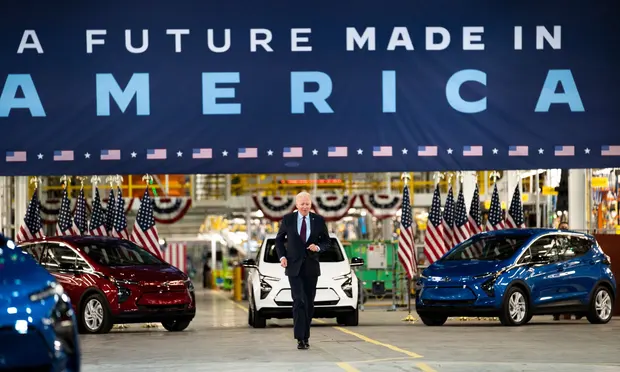The Automobile Industry's Resistance To EV Mandates Grows

Economic Concerns Fueling Industry Pushback
The transition to electric vehicles represents a massive undertaking for the automotive industry, demanding significant upfront investments. The shift away from the internal combustion engine (ICE) and towards electric powertrains necessitates substantial capital expenditure across the entire value chain.
-
High Initial Investment: Developing and manufacturing EVs requires considerable investment in battery technology, a key component driving up production costs. This includes research and development (R&D) for more efficient and longer-lasting batteries, as well as the construction of new manufacturing facilities or the costly retooling of existing ones.
-
Job Displacement Concerns: The automotive industry employs millions globally, many in sectors heavily reliant on the production and maintenance of ICE vehicles. A rapid shift to EVs could lead to significant job losses in these traditional manufacturing sectors, prompting concerns about workforce displacement and economic disruption in affected communities.
-
Profitability Challenges: The current economics of EV production pose significant challenges to profitability. While battery costs are gradually decreasing, they remain a major expense. Furthermore, consumer demand, although growing, is not yet sufficient to offset the higher production costs, potentially leading to decreased profit margins compared to ICE vehicles in the short term.
-
Uncertainty Surrounding Consumer Adoption: The long-term success of EVs hinges on widespread consumer adoption. Uncertainties regarding consumer acceptance, charging infrastructure availability, and the overall market readiness for mass EV adoption remain significant factors influencing industry investment decisions.
Technological Hurdles and Infrastructure Gaps
Despite significant advancements, current EV technology still faces limitations that hinder widespread adoption. These technological hurdles, coupled with inadequate infrastructure, contribute to the industry's concerns regarding the feasibility of meeting ambitious EV mandate targets.
-
Range Anxiety and Charging Times: Many consumers are hesitant to switch to EVs due to concerns about limited driving range ("range anxiety") and comparatively longer refueling times compared to gasoline-powered vehicles.
-
Battery Lifespan and Replacement Costs: The lifespan and eventual replacement costs of EV batteries are significant concerns for both consumers and the industry. Battery degradation and the environmental impact of battery disposal remain unresolved issues.
-
Inadequate Charging Infrastructure: The lack of widespread and reliable charging infrastructure, particularly in rural areas, represents a significant obstacle to EV adoption. The uneven distribution of charging stations and potential grid capacity constraints create additional challenges.
-
Need for Grid Upgrades: The increased electricity demand from a large-scale EV adoption necessitates significant upgrades to existing power grids. This requires substantial investment in grid infrastructure and renewable energy sources to ensure a sustainable energy supply for electric vehicles.
Consumer Preferences and Market Readiness
Consumer behavior plays a crucial role in the success of EV mandates. While EV adoption is increasing, several factors continue to influence consumer purchasing decisions and hamper the speed of transition.
-
High Purchase Price: The initial purchase price of EVs typically remains higher than comparable ICE vehicles, representing a significant barrier for many consumers.
-
Limited Model Availability: The range of available EV models, particularly in certain market segments like larger vehicles or high-performance cars, remains limited, restricting consumer choice.
-
Range Anxiety and Charging Concerns: As mentioned earlier, range anxiety and concerns about charging convenience and accessibility continue to deter potential EV buyers.
-
Need for Increased Consumer Education: Lack of awareness and understanding of EV technology, its benefits, and the environmental impact of ICE vehicles necessitates increased consumer education campaigns to drive adoption.
Government Policies and Regulatory Challenges
Government policies play a pivotal role in shaping the transition to electric vehicles. However, the implementation of EV mandates presents significant challenges, requiring careful consideration of economic impacts and the potential for unintended consequences.
-
Variability in Government Incentives and Regulations: The lack of consistency in government incentives and regulations across different countries creates uncertainties for automakers, hindering their ability to make long-term investment decisions.
-
Balancing Environmental Goals with Economic Realities: Governments face the challenge of balancing ambitious environmental goals with the economic realities of the automotive industry and the need to avoid job losses and economic disruption.
-
Potential for Unintended Consequences: Overly aggressive EV mandates without considering the supporting infrastructure and market readiness could lead to unintended negative consequences, such as supply chain disruptions or market distortions.
-
Need for Clear and Consistent Policy Frameworks: Clear, consistent, and predictable policy frameworks are essential to provide automakers with the certainty they need to invest in EV technology and infrastructure.
Conclusion
The automotive industry's resistance to EV mandates arises from a confluence of economic, technological, and consumer-related factors. High upfront costs, technological limitations, inadequate infrastructure, and consumer hesitancy all contribute to the industry's concerns. However, the transition to electric vehicles is essential for environmental sustainability. Finding a sustainable path for electric vehicle adoption requires a collaborative effort between policymakers and the automotive industry. This involves developing collaborative strategies for EV mandates that account for the economic realities of the transition, investing in charging infrastructure and grid modernization, and implementing effective consumer education campaigns. By fostering a balanced approach that considers both environmental sustainability and economic viability, we can effectively manage the transition to electric vehicles and pave the way for a cleaner and more sustainable transportation future.

 The Future Of Phones Nothings Modular Approach
The Future Of Phones Nothings Modular Approach
 Nvidias Future Navigating Geopolitical Uncertainty Post Trump
Nvidias Future Navigating Geopolitical Uncertainty Post Trump
 Gillian Anderson Back To The X Files But Not Without Apprehension
Gillian Anderson Back To The X Files But Not Without Apprehension
 Leo Carlssons Two Goals Not Enough Ducks Lose To Stars In Overtime
Leo Carlssons Two Goals Not Enough Ducks Lose To Stars In Overtime
 The X Files Ryan Coogler On A Potential Reboot And Discussions With Gillian Anderson
The X Files Ryan Coogler On A Potential Reboot And Discussions With Gillian Anderson
